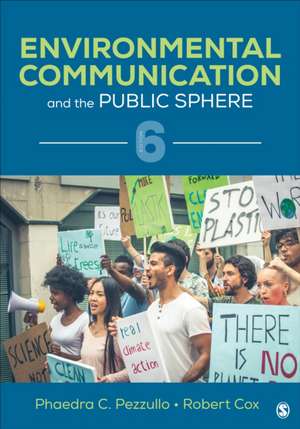Environmental Communication and the Public Sphere
Autor Phaedra C. Pezzullo, Robert Coxen Limba Engleză Paperback – 21 iun 2021
Preț: 695.37 lei
Preț vechi: 939.70 lei
-26% Nou
133.05€ • 139.67$ • 110.44£
Carte disponibilă
Livrare economică 21 martie-04 aprilie
Livrare express 06-12 martie pentru 33.78 lei
Specificații
ISBN-10: 1544387032
Pagini: 392
Dimensiuni: 178 x 254 x 17 mm
Greutate: 0.61 kg
Ediția:Sixth Edition
Editura: SAGE Publications
Colecția Sage Publications, Inc
Locul publicării:Thousand Oaks, United States
Cuprins
Introduction: Speaking for/About the Environment
About the Authors
Part I: Communicating for/About the Environment
Chapter 1: Defining Environmental Communication
Studying Environmental Communication
Communication, the Environment, and the Public Sphere
Diverse Environmental Voices in the Public Sphere
Summary
Suggested Resources
Key Terms
Discussion Questions
Chapter 2: Contested Meanings: A Brief History
Turtle Island
Learning to Love Nature
Wilderness Preservation Versus Natural Resource Conservation
Public Health and the Ecology Movement
Environmental Justice: Linking Social Justice and Public Health
Contemporary Movements for Sustainability and Climate Justice
Summary
Suggested Resources
Key Terms
Discussion Questions
Chapter 3: Symbolic Constructions of the Environment
A Rhetorical Perspective
Dominant and Critical Discourses
Summary
Suggested Resources
Key Terms
Discussion Questions
Chapter 4: Environmental Media and Sustainability
The Environment and Popular Culture
Sustainability: An Interdisciplinary Approach
Sustainability Discourses
Corporate Sustainability Communication: Reflection or Deflection?
Greenwashing
Summary
Suggested Resources
Key Terms
Discussion Questions
Part II: Environmental Campaigns and Movements
Chapter 5: Environmental Advocacy Campaigns
Environmental Advocacy
Environmental Advocacy Campaigns
The Campaign to Protect Zuni Salt Lake
Summary
Suggested Resources
Key Terms
Discussion Questions
Chapter 6: Digital Environmental Organizing
Grassroots Activism and Digital Media
Environmental NGOs and Digital Campaign Dilemmas
Multimodality and Networked Campaigns
Summary
Suggested Resources
Key Terms
Discussion Questions
Chapter 7: Visual and Market Advocacy
Visual Rhetoric and Nature Advocacy
Moving Images of Disasters
Summary
Suggested Resources
Key Terms
Discussion Questions
Chapter 8: Environmental Justice and Climate Justice Movements
Environmental Justice: Challenges, Critiques, and Change
Honoring Frontline Knowledge and Traveling on Toxic Tours
The Global Movement for Climate Justice
Summary
Suggested Resources
Key Terms
Discussion Questions
Part III: Environmental Discourses and Public Spheres
Chapter 9: Environmental Journalism
Environmental Journalism in the Public Sphere
Breaking News and Environmental Journalism
Media Effects and Influences
Digital Storytelling and Environmental News
Summary
Suggested Resources
Key Terms
Discussion Questions
Chapter 10: Science and Climate Communication
Scientific Argumentation
Early Warners: Environmental Scientists and the Public
Resisting (Climate) Science
Communicating Climate Science
Summary
Suggested Resources
Key Terms
Discussion Questions
Chapter 11: Public Health and Environmental Risk Communication
Dangerous Environments: Assessment in a Risk Society
Communicating Environmental Risks in the Public Sphere
The Precautionary Principle
Citizens Becoming Scientists
Voices of Environmental Risk
Summary
Suggested Resources
Key Terms
Discussion Questions
Part IV: Green Governance and Legal Spheres
Chapter 12: Public Participation and Democratic Rights
Rights of Public Participation
Right to Know: Transparency and Access to Information
Right to Comment: Involvement
SLAPP: Strategic Litigation Against Public Participation
Growth of Public Participation Internationally
Summary
Suggested Resources
Key Terms
Discussion Questions
Chapter 13: Voice and Public Dissent
Right of Expression and Right of Assembly
Right of Standing: Who Legally Can Speak?
Landmark Cases on Environmental Standing
Reversing, Slowing, or Reducing Global Warming as Injury
Who Should Have a Right of Standing?
Summary
Suggested Resources
Key Terms
Discussion Questions
Epilogue: Imagining Stories of/for Our Future
Glossary
References
Index
Notă biografică
Phaedra C. Pezzullo is Associate Professor at the University of Colorado Boulder, and a dual citizen with the US and Italia. Her interdisciplinary background informs her research on environmental justice, climate justice, just transition, public advocacy, and tourist studies. Her book, Toxic Tourism (University of Alabama Press, 2007), won four awards, including the Jane Jacobs Urban Communication Book Award and the National Communication Association¿s Environmental Communication Division Book Award. Among other publications, she coedited Green Communication and China (Michigan State University Press, 2020) and Environmental Justice and Environmentalism (MIT Press, 2007). She was a founding editor of the journal Environmental Communication and serves on its editorial board. She has volunteered on the Sierra Club¿s national Environmental Justice Committee and Affinity Group Working Group, consulted with cities and counties on a just transition, and was a delegate at COP21 in Paris. Pezzullo is a founding co-director of the Center for Creative Climate Communication and Behavior Change (C3BC) on her campus. She also enjoys outdoor recreation and cooking a plant-based diet.
